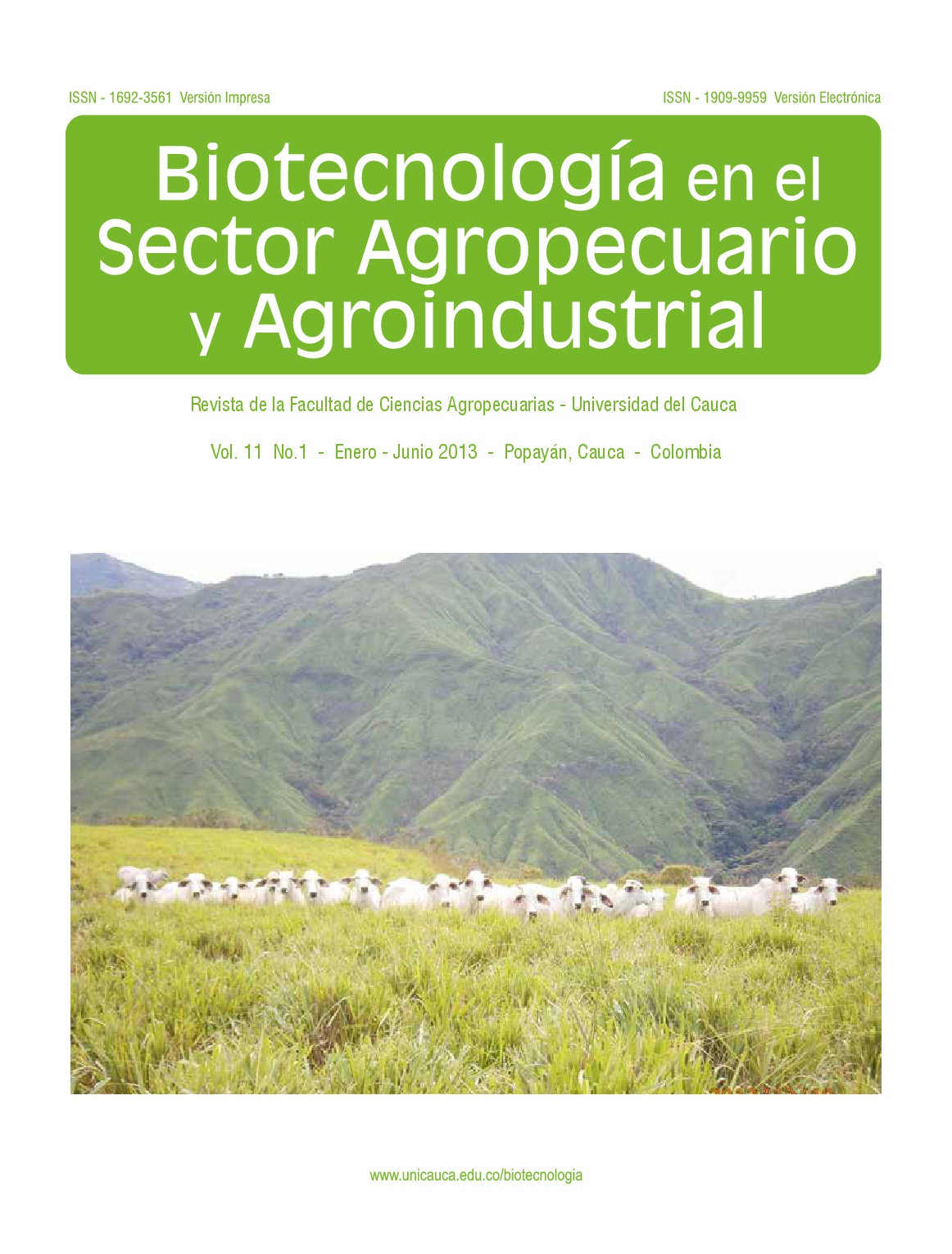Caracterización fisicoquímica del mango común (mangifera indica l.) durante su proceso de maduración
Resumen
El proceso de maduración del mango está gobernado bajo una serie de reacciones bioquímicas al interior del fruto que se caracterizan por cambios en la textura, color, en el contenido de azúcares, ácidos, aromas, entre otros. Las sustancias acumuladas durante el desarrollo se transforman de manera lenta y progresiva hasta que el fruto alcanza las condiciones de aroma y jugosidad que permita clasificarlo como maduro. Se realizó una cinética de maduración durante nueve días, determinando parámetros físicos y químicos como color en pulpa y en cáscara, textura, actividad de agua, sólidos solubles, pH y acidez titulable. Se modeló cinéticamente el comportamiento de cada una estas variables y se pudo determinar que los sólidos solubles tienen una tendencia explicada con un modelo de regresión multiplicativo y la actividad de agua con un modelo de regresión reciproco de X mientras el pH y la acidez con una ecuación de regresión de raíz cuadrada de X, de la misma manera el cambio de color en cáscara y en pulpa presento una regresión reciproca de X. Por último en el caso de la textura se observó y se ajustó modelos lineales tanto para cáscara como para pulpa.
Descargas
Lenguajes:
es;enAgencias de apoyo:
Universidad del Quindío, Colegio de Postgraduados Campus San Luis Potosí (México).Referencias bibliográficas
MEJÍA, L.F., MARTÍNEZ, H., BETANCOURT, J. y CASTRILLÓN, C. Aprovechamiento del residuo agroindustrial del mango común (Mangifera indica l.) en la obtención de azúcares fermentables. Ingeniería y Ciencia, 3 (6), 2007, p. 41-62.
JOAS, J., CARO, Y. and LECHAUDEL, M. Comparison of postharvest changes in mango (cv Cogshall) using a ripening class index (Rci) for different carbon supplies and harvest dates. Postharvest Biology and Technology, 54 (1), 2009, p. 25-31.
MORGA, S., LUSTRE, O., TUNAC, M., BALAGOT, H. and SORIANO, R. Physico-chemical changes in Philippine Carabao mangoes during ripening. Food Chemistry, 4 (3), 1979, p.225-234.
MONTALVO, E., GARCIA, H., TOVAR, B. and MATA, M. Application of exogenous ethylene on postharvest ripening of refrigerated "ataulfo” mangoes. LWT-Food Science and Technology, 40(8), 2007, p. 1466-1472.
GENARD, M. and GOUBLE, E. Ethy. A Theory of fruit climacteric ethylene emission. Plant Physiology, 139(1), 2005, p. 531 - 545.
MONTGOMERY, C. Diseño y análisis de experimentos. 2 ed. México (México): Grupo Editorial Iberoamérica, 1991, 589 p.
ROJAS, C., PÉREZ, M., COLINAS, T., SAHAGÚN, J. y AVITIA, E. Modelos matemáticos para estimar el crecimiento del fruto de chile manzano (Capsicum pubescens R y P). Revista Chapingo Serie Horticultura, 14 (3), 2008, p. 289-294.
SLAUGHTER, D.C. Nondestructive maturity assessment methods for mango: A Review of Literature and Identification of Future Research Needs. Biological and Agricultural Engineering , 2009, p. 1-18.
JHA, S., CHOPRA, S. and KINGSLY, A. Modeling of color values for nondestructive evaluation of maturity of mango. Journal of Food Engineering, 78 (1), 2007, p. 22-26.
SUBEDI, P., WALSH, K. and OWENS, G. Prediction of mango eating quality at harvest using short-wave near infrared spectrometry. Postharvest Biology and Technology, 43 (3), 2007, p. 326-334.
MOHD, Z., CHIN, L.H. and LAZAN, H. A comparative study on wall degrading enzymes, pectin modifications and softening during ripening of selected tropical fruits. Plant Science, 167 (2), 2004, p. 317-327.
SUBRAMANYAM, H., KRISHNAMURTHY, S. and PARPIA, H.A.B. Physiology and biochemistry of mango fruit. Advances in Food Research, (21), 1975, p. 223-305.
SCHMILOVITCH, Z., MIZRACH, A., HOFFMAN, A., EGOZI, H. and FUCHS, Y. Determination of mango physiological indices by near-infrared spectrometry. Postharvest Biology and Technology, 19 (3), 2000, p. 245-252.
CASTRILLO, M., KRUGER, N. and WHATLEY, R. Sucrose metabolism in mango fruit during ripening. Plant Science, 84 (1), 1992, p.45-51.
TOVAR, B., GARCIA, H. and MATA, M. Physiology of pre-cut mango. I. ACC and ACC oxidase activity of slices subjected to osmotic dehydration. Food Research International, 34 (2-3), 2001, p. 207-215.
SARANWONG, S., SORNSRIVICHAI, J. and KAWANO, S. Prediction of ripe-stage eating quality of mango fruit from its harvest quality measured nondestructively by near infrared spectroscopy. Postharvest Biology and Technology, 31 (2), 2004, p. 137-145.
BRICENO, S., ZAMBRANO, J. y MATERANO, W. Calidad de los frutos de mango ‘bocado’, madurados en la planta y fuera de la planta cosechados en madurez fisiológica. Agronomía Tropical, 55 (4), 2005, p. 461-473.
MIZRACH, A., FLITSANOV, U. SCHMILOVITCH, Z. and FUCHS, Y.
Determination of mango physiological indices by mechanical wave analysis. Postharvest Biology and Technology, 16 (2), 1999, p. 179-186.
ORNELAS, J., YAHIA, E. and GARDEA, A. Changes in external and internal color during postharvest ripening of "manila” and "ataulfo” mango fruit and relationship with carotenoid content determined by liquid chromatography-APcI+-time-of-flight mass spectrometry. Postharvest Biology and Technology, 50 (2-3), 2008, p. 145-152.
KANG, P., EAST, R. and TRUJILLO, J. Colour vision system evaluation of bicolour fruit: A case study with "B74” mango. Postharvest Biology and Technology, 49 (1), 2008, p. 77-85.
YASHODA, H.M., PRABHA, T.N. and THARANATHAN, R.N. Mango ripening- role of carbohydrases in tissue softening. Food Chemistry, 102 (3), 2007, p. 691-698.
YASHODA, H.M., PRABHA, T.N. and THARANATHAN, R.N. Mango ripening-chemical and structural characterization of pectic and hemicellulosic polysaccharides. Carbohydrate Research, 340 (7), 2005, p. 1335-1342.
MUDA, P., SEYMOUR, B. and ERRINGTON, N., TUCKER, G.A. Compositional changes in cell wall polymers during mango fruit ripening. Carbohydrate Polymers, 26 (4), 1995, p. 255-260.
AJILA, M., BHAT, G. and PRASADA, U. Valuable components of raw and ripe peels from two Indian mango varieties. Food Chemistry, 102 (4), 2007, p. 1006-1011.
VIDHU, S., AMITA, C. and PRAVENDRA, N. Softening in mango (Mangifera indica cv. Dashehari) is correlated with the expression of an early ethylene responsive, ripening related expansin gene, MiExpA1. Postharvest Biology and Technology, 38 (3), 2005, p. 223-230.


 Español
Español Inglés
Inglés





















.png)



